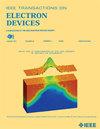A Charge-Domain Design of Ferroelectric Tunneling Junction Synapse for Spiking Neural Networks
IF 2.9
2区 工程技术
Q2 ENGINEERING, ELECTRICAL & ELECTRONIC
引用次数: 0
Abstract
A charge-domain design of synaptic circuits based on ferroelectric tunnel junctions (FTJs) is proposed in this work. The device characteristics of experimental FTJs are analyzed, including their varactor properties, voltage-modulated tunneling electro-resistance (TER), and their significant displacement current, which challenge the circuit designs. A charge-domain design strategy is deployed to adapt this uniqueness, and a synaptic FTJ cell with the spiking-time-dependent-plasticity (STDP) rule is developed. With a TCAD-simulated FTJ of representative characteristics, the synaptic cell comprises seven transistors and one FTJ, mitigating the impacts of capacitive current and amplifying the differences of resistance states. Functional design and parameter tuning of leaky integrate-and-fire (LIF) neurons were performed. Using SPICE simulation, FTJ synapses were connected to LIF neurons, forming a low-power, unsupervised spiking neural network (SNN). Trained and tested on Modified National Institute of Standards and Technology (MNIST) handwritten digits, it achieved 88% classification accuracy. This confirms the self-learning ability of the FTJ-based neural network circuit, offering insights for neuromorphic computing advancements.求助全文
约1分钟内获得全文
求助全文
来源期刊

IEEE Transactions on Electron Devices
工程技术-工程:电子与电气
CiteScore
5.80
自引率
16.10%
发文量
937
审稿时长
3.8 months
期刊介绍:
IEEE Transactions on Electron Devices publishes original and significant contributions relating to the theory, modeling, design, performance and reliability of electron and ion integrated circuit devices and interconnects, involving insulators, metals, organic materials, micro-plasmas, semiconductors, quantum-effect structures, vacuum devices, and emerging materials with applications in bioelectronics, biomedical electronics, computation, communications, displays, microelectromechanics, imaging, micro-actuators, nanoelectronics, optoelectronics, photovoltaics, power ICs and micro-sensors. Tutorial and review papers on these subjects are also published and occasional special issues appear to present a collection of papers which treat particular areas in more depth and breadth.
 求助内容:
求助内容: 应助结果提醒方式:
应助结果提醒方式:


